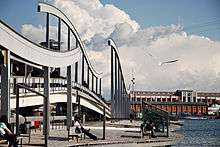Port of Barcelona
Coordinates: 41°20′15″N 2°9′8″E / 41.33750°N 2.15222°E
| Port of Barcelona | |
|---|---|
 | |
| Location | |
| Country | Spain |
| Location | Barcelona |
| Details | |
| Land area | 10.653 square kilometres (1,065.3 ha)[1] |
| Statistics | |
| Vessel arrivals | 7,727 vessels (2013)[2] |
| Annual cargo tonnage | 42,434,176 tonnes (2013)[2] |
| Annual container volume | 1,720,383 TEU's (2013)[2] |
| Passenger traffic | 3.628.129 (2013)[2] |
|
Website http://www.portdebarcelona.cat/ | |

The Port of Barcelona (Catalan: Port de Barcelona, IPA: [ˈpɔr ðə βərsəˈɫonə]; Spanish: Puerto de Barcelona) has a 2000-year history and great contemporary commercial importance as one of Europe's ports in the Mediterranean, as well as Catalonia's largest port, tying with Tarragona. It is also Spain's third and Europe's ninth largest container port, with a trade volume of 2.57 million TEU's in 2008.[3] The port is managed by the Port Authority of Barcelona. Its 7.86 km2 (3 sq mi) are divided into three zones: Port Vell (the Old Port), the commercial/industrial port and the logistics port (Barcelona Free Port). The port is undergoing an enlargement that will double its size by diverting the mouth of the Llobregat river 2 km (1¼ mi) to the south,[4] and slightly pushing back the Llobregat Delta Nature Reserve.
This is not the only port in Barcelona, as there are also two additional yacht harbors / marinas: Port Olímpic and Port Fòrum Sant Adrià to the north.
Overview
The Port Vell area comprises two marinas or yacht harbors, a fishing port, a maritime station for ferries travelling to the Balearic Islands and other destinations in the Mediterranean and other stations or landing areas for cruise ships, and it abuts the industrial port.
In the central area, it also houses "Maremagnum" (a shopping mall and nightlife complex), a multiplex cinema, the IMAX Port Vell (large-format cinema complex) and Europe's largest aquarium, containing 8,000 fish and 11 sharks in 22 basins filled with 6 million litres of sea water. Because it is located in a designated tourist zone, the Maremagnum is the only commercial mall in the city that can open on Sundays and public holidays. Next to the Maremagnum area are the "Golondrines", small ships that take tourists for a visit around the port area and beyond.

The Barcelona industrial port is to the south, and comprises the Free Port or Zona Franca de Barcelona, a tariff-free industrial park that has developed within the Port of Barcelona, across the flat land of the Llobregat Delta between the city of Barcelona and that of El Prat de Llobregat and the Barcelona International Airport to the south.
A good place to view both the industrial and pleasure port is from Montjuïc, and more specifically, from Montjuïc Castle, as well as from the aerial cable car connecting Barceloneta with the Ferry Station and Montjuïc.
Information

In common with much of Western Europe, the older traditional industries in Spain, such as textiles, declined in the face of foreign competition. The surviving companies closed their factories in the city or along the rivers, leaving industrial wastelands or abandoned workers' colonies. In many cases within Spain, these industries moved to the Zona Franca (Catalan: Polígon Industrial de la Zona Franca).
The free trade area was constructed in two phases. The first phase covered an area of 70 hectares; the second phase, covering an area of 140 hectares, started construction in 1995.
The free trade zone is located within the port area, not far away from downtown Barcelona, and is easy to access. It is 5 kilometres (3.1 mi) away from the Barcelona International Airport, and connected via highway and railway.


Business investors here rent offices or bonded warehouses. They can also elect to purchase land to erect their own buildings.
The free trade zone offers a series of services. It is divided into a comprehensive service area, truck / lorry area, reception area and sports facilities area. It has a customs duties service, bonded warehousing service, advanced telecommunication and computer system, security system, combined multiple transport system and so on.
Destinations
- Alcudia by Balearia
- Ciutadella by Balearia
- Ibiza by Balearia and Trasmediterranea
- Mahon by Trasmediterranea
- Palma, Majorca by Balearia and Trasmediterranea
- Civitavecchia by Grimaldi Lines
- Genoa by Grandi Navi Veloci
- Livorno by Grimaldi Lines
- Porto Torres by Grimaldi Lines
- Savona by Grimaldi Lines
- Tangeri by Grandi Navi Veloci and Grimaldi Lines
See also
- Port Vell
- Port Olímpic
- Zona Franca – Port
- List of ports in Spain
- List of busiest ports in Europe
- Royal Barcelona Yacht Club
- Barcelona Royal Shipyard
- Barcelona power station
References
- ↑ http://www.portdebarcelona.es/en/web/el-port/informacion-general
- 1 2 3 4 Port of Barcelona traffic statistics 2013 - Port de Barcelona, 2014
- ↑ AAPA World Port Rankings 2008
- ↑ "Port de Barcelona" (in Catalan). Apb.es. Retrieved 2010-06-26.
External links
| Wikimedia Commons has media related to Port of Barcelona. |
- Official website (English) (Catalan) (French) (Spanish)